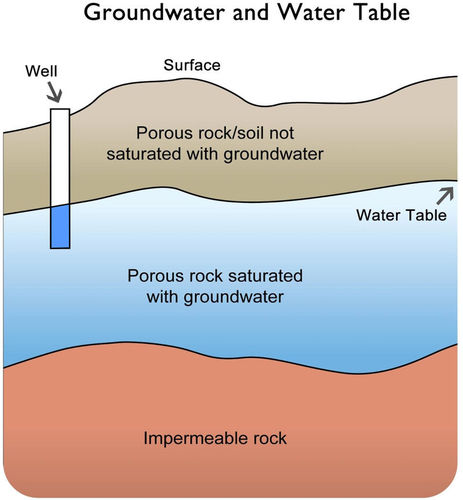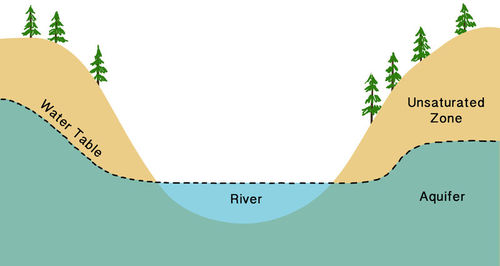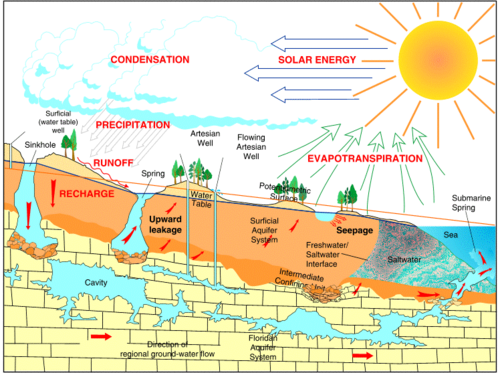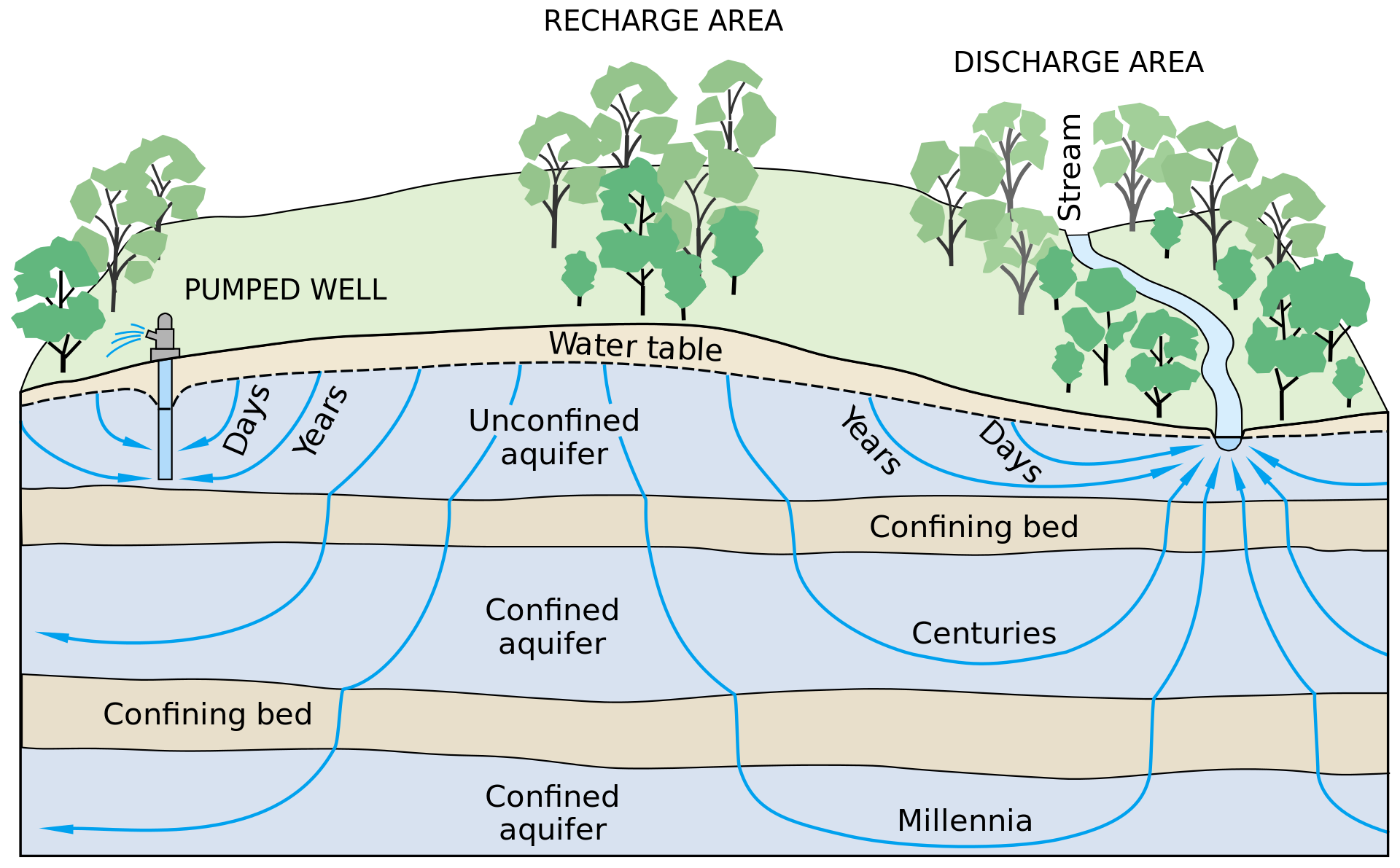67 Groundwater
Groundwater is the largest reservoir of liquid fresh water on Earth and is found in aquifers, porous rocks and sediments with water in between pore space.
How water moves in soils/sediments?
Water is attracted to the soil particles and capillary action moves water from wet soil to dry areas.
Aquifers are found at different depths. Some are just below the surface and some are found much deeper below the land surface. A region may have more than one aquifer beneath it and even most deserts are above aquifers. The source region for an aquifer beneath a desert is likely to be far from where the aquifer is located; for example, it may be in a mountain area.
The amount of water that is available to enter groundwater in a region is influenced by the local climate, the slope of the land, the type of rock found at the surface, the vegetation cover, land use in the area, and water retention, which is the amount of water that remains in the ground.
More water goes into the ground where there is a lot of rain, flat land, porous rock, exposed soil, and where water is not already filling the soil and rock.
The residence time of water in a groundwater aquifer can be from minutes to thousands of years.
Groundwater is often called “fossil water” because it has remained in the ground for so long, often since the end of the ice ages.
Aquifers
Features of an Aquifer
To be a good aquifer (i.e. to yield more water for consumption), the sediment in the aquifer must have high:
- porosity: small spaces between grains; measured as a fraction of the volume of voids over the total volume of soil/sediment, as a percentage between 0% and 100%.
- permeability: is a measure of the ability of a soil/sediment to allow water to pass through it; it depends on porosity and also sorting of soil/sediment particles.
To reach an aquifer, surface water infiltrates downward into the ground through tiny spaces or pores in the rock. The water travels down through the permeable rock until it reaches a layer that has very low porosity or does not have pores; this rock is called impermeable (figure 1).
This impermeable rock layer forms the base of the aquifer and is called aquitard.
The upper surface where the groundwater is available is the water table.
Water table marks the upper boundary of saturated zone, just below unsaturated zone where water infiltrates from the surface.

The Water Table
For a groundwater aquifer to contain the same amount of water, the amount of recharge must equal the amount of discharge. What are the likely sources of recharge? What are the likely sources of discharge?

Figure 2. The top of the stream is the top of the water table. The stream feeds the aquifer.
In wet regions, streams are fed not only by surface runoff but also by groundwater; the surface of the stream is the top of the water table (figure 2). In dry regions, water seeps down from the stream into the aquifer. These streams (ephemeral streams) are often dry much of the year.
In mountainous terrain water leaves a groundwater reservoir and forms streams or springs.
What happens to the water table when there is a lot of rainfall? What happens when there is a drought? Although groundwater levels do not rise and fall as rapidly as at the surface, over time the water table will rise during wet periods and fall during droughts.
One of the most interesting, but extremely atypical types of aquifers is found in Florida. Although aquifers are very rarely underground rivers, in Florida water has dissolved the limestone so that streams travel underground and above ground (figure 3). This process of dissolution of carbonate rocks is called karst.

Karst Topography
Introduction
Throughout the world karst landscapes vary from rolling hills dotted with sinkholes, as found in portions of the central United States, to jagged hills and pinnacle karst found in the tropics. The development of all karst landforms requires the presence of rock which is capable of being dissolved by surface water or ground water.
The term karst describes a distinctive topography that indicates dissolution (also called chemical solution) of underlying soluble rocks by surface water or ground water. Although commonly associated with carbonate rocks (limestone and dolomite) other highly soluble rocks such as evaporates (gypsum and rock salt) can be sculpted into karst terrain.
Understanding caves and karst is important because ten percent of the Earth’s surface is occupied by karst landscape and as much as a quarter of the world’s population depends upon water supplied from karst areas. Though most abundant in humid regions where carbonate rock is present, karst terrain occurs in temperate, tropical, alpine and polar environments. Karst features range in scale from microscopic (chemical precipitates) to entire drainage systems and ecosystems which cover hundreds of square miles, and broad karst plateaus.
Although karst processes sculpt beautiful landscapes, karst systems are very vulnerable to ground water pollution due to the relatively rapid rate of water flow and the lack of a natural filtration system. This puts local drinking water supplies at risk of being contaminated. In the mid 1980’s, flooding of caves in the highly populated area of Bowling Green, Kentucky, caused industrial waste to leak into the vast system of underground fissures polluting the ground water in local wells. Due to urban expansion millions of dollars is spent annually in the United States to repair damage to roads, buildings and other structures which are built on unstable karst surfaces.
Karst Topography
The degree of development of karst landforms varies greatly from region to region. Large drainage systems in karst areas are likely to have both fluvial (surface) and karst (underground) drainage components. As stated in the introduction, the term karst describes a distinctive topography that indicates dissolution of underlying carbonate rocks by surface water or ground water.
Water falls as rain or snow and soaks into the soil. The water becomes weakly acidic because it reacts chemically with carbon dioxide that occurs naturally in the atmosphere and the soil. This acid is named carbonic acid and is the same compound that makes carbonated beverages taste tangy. Rainwater seeps downward through the soil and through fractures in the rock responding to the force of gravity. The carbonic acid in the moving ground water dissolves the bedrock along the surfaces of joints, fractures and bedding planes, eventually forming cave passages and caverns.
Limestone is a sedimentary rock consisting primarily of calcium carbonate in the form of the mineral calcite. Rainwater dissolves the limestone by the following reaction: Calcite + Carbonic acid = Calcium ions dissolved in ground water + Bicarbonate ions dissolved in ground water.
Cracks and joints that interconnect in the soil and bedrock allow the water to reach a zone below the surface of the land where all the fractures and void spaces are completely filled (also known as saturated) with water. This water-rich zone is called the saturated zone and its upper surface is called the water table. The volume of void space (space filled with air or water) in soil or bedrock is termed porosity. The larger the proportion of voids in a given volume of soil or rock the greater the porosity. When these voids are interconnected, water or air (or other fluids) can migrate from void to void. Thus the soil or bedrock is said to be permeable because fluids (air and water) can easily move through them. Permeable bedrock makes a good aquifer, a rock layer that holds and conducts water. If the ground water that flows through the underlying permeable bedrock is acidic and the bedrock is soluble, a distinctive type of topography, karst topography, can be created.
The first part of our animation shows evolution of karst landforms created by downward movement of water accompanied by dissolution of rock and mass transport of sediments in stream channels. In tropical areas with thick massive limestones, a remarkable and distinctive landscape of jagged hills and narrow gorges completely dominates the landscape. Movement of solution along fractures and joints etches the bedrock and leaves limestone blocks as isolated spires or pinnacles. Pinnacles range from small features a few inches tall to intermediate forms a few feet tall to large pinnacles hundreds of feet tall. Besides the etching of pinnacles and residual hills, sheets of flowing water move down sloping surfaces creating a variety of etched surface features. Our computer animation shows the dominant landforms, such as pinnacles, cones, and towers, commonly found in the tropical karst environment of northern Puerto Rico.
Our paper model represents another type of karst landscape, that of a rolling limestone plain such as is found in south-central Kentucky, northern Florida, and the Highland Rim of central Tennessee where doline karst is the dominate feature. Doline karst is the most widely distributed type of karst landscape. The landscape is dotted with sinkholes (dolines) which can vary widely in number and size. For the Sinkhole Plain in central Kentucky, there are approximately 5.4 sinkholes per square kilometer over a 153 square kilometer area. For north Florida there are almost 8 sinkholes per square kilometer over a 427 square kilometer area (White, 1988, table 4.1, page 100).
Karst topography dominated by sinkholes or dolines usually has several distinct surface features. Our paper model shows features normally associated with karst topography. Sinkholes (also known as dolines) are surface depressions formed by either: 1) the dissolution of bedrock forming a bowl-shaped depression, or 2) the collapse of shallow caves that were formed by dissolution of the bedrock. These sinkholes or shallow basins may fill with water forming lakes or ponds. Springs are locations where ground water emerges at the surface of the earth. Disappearing streams are streams which terminate abruptly by flowing or seeping into the ground. Disappearing streams are evidence of disrupted surface drainage and thus indicate the presence of an underground drainage system. Cave entrances are natural openings in the earth large enough to allow a person to enter. Caves may reflect a complex underground drainage system.
| * Numbers are rounded to nearest kilometer | ||
| A Brief List of the Longest Caves in the United States | ||
|---|---|---|
| Name | Location | Distance Mapped* |
| Mammoth Cave—Flint Ridge System | Kentucky | 500 km |
| Jewel Cave | South Dakota | 118 km |
| Wind Cave | South Dakota | 73 km |
| Friars Hole System | West Virginia | 68 km |
| Fisher Ridge Cave System | Kentucky | 64 km |
What do Caves Contain?
Moving water may transport earth materials into and through caves physically or chemically. Caves contain interesting features as a result of the physical and chemical processes that form them. Among these features are breakdown blocks of rock formed by collapse of cave ceilings. Also seen are sediments containing boulders, sand, silt, and clay deposited from water flowing in and through cave passages and conduits. Speleogens are irregular or distinctive shapes of carbonate rock etched from bedrock by dripping or running water. Speleogens can form where bedrock is not uniform in chemical composition. Consequently, the less soluble rock dissolves slower than adjacent more soluble rock through time. The less soluble rock tends to stand in relief and projects from walls and ceilings of caves.
Away from their entrances, caves usually provide a relatively constant temperature and humidity over a long period of time. Thus, caves provide an ideal environment for chemical deposition of minerals. As water laden with dissolved carbonate seeps into the air-filled cave passage, it may lose excess carbon dioxide to the cave atmosphere, or the water itself may evaporate, causing the dripwater to precipitate secondary carbonate or other minerals from solution, creating cave formations or speleothems including cone-shaped stalactites, stalagmites, flowstone or rimstone, or other interesting shapes. Caves in karst areas often have stalactites (icicle-like masses of chemical limestone) that hang from cave ceilings and stout stalagmites protruding from the cave floor. Stalactites and stalagmites can be a few inches to several feet long. Sometimes the drip water will flow down the walls and over the cave floor creating flowstone or rimstone deposits. Where drip water seeps from a joint and then drips over the edges of ledges, deposits of great complexity known as draperies are formed. The color of dripstones and flowstones comes from organic and/or iron oxide compounds brought in from the surface, giving the speleothems an orange brown color or from the presence of oxides and hydroxides of iron and manganese which give the speleothems a deep brown or black color.
What Lives Underground?
Some scientists are interested in cave ecology and how cave animals interact with cave microclimates. Animals found in caves include everything from surface dwelling animals like raccoons that occasionally use the cave, to animals that have adapted exclusively to life in the cave (troglobites). Troglobites cannot survive outside caves. These may include such diverse animals as eyeless fish and crayfish, cave beetles, flatworms, and other unusual types of insects. Many of these animals have lost body pigmentation and are white or transparent in color. Although the cave environment appears to be stable, change can and does occur. The temperature of the cave varies due to air movement near the entrances and the temperature of water entering the cave. In reality, some caves have their own weather systems which create wind due to temperature and pressure differences between the entrance and interior passageways.
Many animals, such as bats, cave crickets, and pack rats, regularly visit, raise their young, or hibernate in caves. These animals are called trogloxenes . Caves may support large numbers of different types of bats. Bats may be among the most beneficial animals to people and the ecosystem as insect-eaters and plant pollinators. The little brown bat can eat 600 mosquitoes in an hour thus performing the work of a “natural insecticide,” helping control crop pests and other insects. The Mammoth Cave-Flint Ridge System in Kentucky, which is the most extensive cave system in the world, has a biodiversity of 43 mammals, 15 reptiles, 19 amphibians and 3 fish. In 1981, the United Nations designated Mammoth Cave National Park as a World Heritage Site. Follow this link for an excellent summary of the Mammoth Cave area and other caves found in the U. S. National Park System.
In 1988 the United States passed the Federal Cave Resource Protection Act which preserves and protects all significant caves found on federal land for future generations of Americans.
What’s in it for Me?
Knowing where karst features are located could help city and town planners, as well as individual landowners, to make decisions on where to build houses and other structures. This information could save cities thousand of dollars in repairs to buildings that are built on unstable karst terrain.
Karst springs supply drinking water to millions of people. Knowledge of karst terrain and the movement of water in underground drainage systems is important for maintaining good quality and safe drinking water. Pollution of ground water is a major problem in karst terrain.
Caves provide a venue for recreation. Although most of the caves located in National Parks are protected, there are over 200 commercial show caves nationwide which are open to the public. Recreational caving has become a popular hobby. The National Speleological Society has about 20,000 active affiliates nationwide.
Deposits preserved in caves can tell geologists about past climates. Fossils and artifacts found in caves help geologists and archaeologists unravel the prehistory of an area.
Caves support a unique community of bacteria, fungi and animals not seen on the surface of the Earth.
Questions
- Why is there often a wind at the mouth of a cave?
- Do large caves form in dry environments above the water table?
- Do dripstone features such as stalactites and stalagmites form in caves that are below or above the water table? Why or why not?
- Is the water table always level?
- Should a person explore a cave alone?
- Should a person build a house near a sinkhole?
- Should a person collect stalactites and stalagmites?
- Should a person collect cave-dwelling animals?
Ancient Cenotes: Underwater Karst
Yuri’s adventure in one of the cenotes (El Eden) near Playa del Carmen in the Yucatan Peninsula.:
General structure of the groundwater flow is shown on figure below. It also includes relative time estimations for various groundwater locations:

– Ground Water And Surface Water A Single Resource. U.S. Geological Survey Circular 1139, Figure 3.
